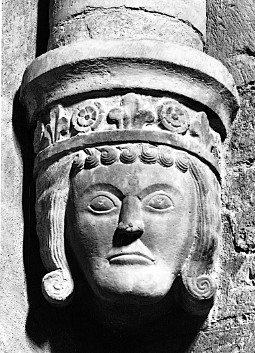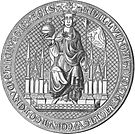
Birger Jarl, also known as Birger Magnusson, was a Swedish statesman and regent, jarl, and a member of the House of Bjelbo, who played a pivotal role in the consolidation of Sweden. His first marriage was to Princess Ingeborg of Sweden, which created his base of power. Birger led the Second Swedish Crusade, which established Swedish rule in Finland. Additionally, he is traditionally attributed with the foundation of the Swedish capital, Stockholm, around 1250. Birger used the Latin title of Dux Sweorum, and the design of his coronet combined those used by continental European and English dukes.

Eric XI Ericsson or Eric the Lisp and Lame was King of Sweden from 1222 to 1229 and again from 1234 to 1250. Being the last ruler of the House of Eric, he stood in the shadow of a succession of powerful Jarls, especially his brother-in-law Birger Jarl, whose descendants ruled as kings after his death.

In modern Swedish, Folkung has two meanings, which appear to be opposites:
- The medieval "House of Bjelbo" in Sweden, which produced several Swedish statesmen and kings.
- A group of people, who were at times in political opposition to the same House of Bjelbo. This "political party" fought for the ancient right of free men to elect the kings in Sweden.

John I was King of Sweden from 1216 until his death in 1222.

Eric X was King of Sweden between 1208 and 1216. Also known as Eric the Survivor, he was, at his accession to the throne, the only remaining son of King Canute I of Sweden and his queen. The name of his mother is not known, but may have been Cecilia.
Sverker II or Sverker the Younger was King of Sweden from 1195 or 1196 to 1208 when he was defeated in the Battle of Lena by Prince Eric. Sverker died in the 1210 Battle of Gestilren where his forces battled those of King Eric X.

TorkelKnutsson was Lord High Constable of Sweden, member of the Privy Council of Sweden (Riksråd), and virtual ruler of Sweden during the early reign of King Birger Magnusson (1280–1321).

The House of Sverker were a powerful political force in medieval Sweden, contesting for royal power. Their origins were in Östergötland. After the extinction of the House of Stenkil and the ascension of Sverker I of Sweden in 1130, a civil war commenced. In the beginning, there were several pretenders, of whom Sverker I emerged as victorious, for a time. The antagonists in long run were finally the House of Sverker in Östergötland and the House of Eric in Västergötland and Uppland, which alternated on the throne for several generations, until in the 1220s the Eric dynasty got the upper hand, and the Sverker dynasty became extinct.

The Battle of Gestilren took place on July 17, 1210. The battle was fought between the exiled King of Sweden Sverker and the ruling King Eric X. Sverker had been beaten in the previous Battle of Lena, but returned with new forces. Sverker was however killed in the battle. The exact strength of the armies is unknown.

Birger Brosa was jarl of Sweden from 1174 to 1202.

Bjälbo is a small village in Mjölby Municipality, Östergötland, Sweden.
Eskil Magnusson was a nobleman and lawspeaker (Lagman) of Västergötland. He is the first attested legal official in what is now Sweden about whom extensive information is available.
Magnus Minniskiöld was a medieval Swedish magnate from the House of Bjelbo. He is best known as the father of the renowned statesman Birger Jarl, and the ancestor of the later Swedish kings. He is sometimes believed to have perished in the Battle of Lena in 1208, though the evidence is not conclusive.
Magnus Henriksson, also known as Magnus II, was a Danish lord and king of Sweden between 1160 and 1161. He is often seen by posterity as a usurper.

Bengt Birgersson was the youngest son of Birger Jarl. He embarked on an ecclesiastical career, becoming the Archdeacon of Linköping in 1273, the Canon of Uppsala in 1275, and the Bishop of Linköping in 1286. When open war broke out between his brothers, King Valdemar and Duke Magnus, Bengt sided with Magnus. After Magnus became King of Sweden in 1275, Bengt served as his chancellor. In 1284, he was granted the title of Duke of Finland.
Knut Birgersson was Riksjarl of Sweden. He was the eldest surviving son of Riksjarl Birger Brosa and a member of the powerful House of Bjälbo also known as the House of Folkung (Folkungaätten).

Ingeborg Eriksdotter was a Swedish princess and duchess, daughter of King Eric X of Sweden, eldest sibling of King Eric XI of Sweden, wife of Birger Jarl, and mother of Kings Valdemar and Magnus III of Sweden.
Folke the Fat, according to Gesta Danorum by the 12th century Danish chronicler Saxo Grammaticus, was the most powerful man in Sweden around 1100. He married Ingegerd Knutsdotter of Denmark, daughter of the Danish king Canute IV who was murdered in 1086. Folke and Ingrid had the sons Knut and Benedict according to Saxo. The chronicler furthermore reports that Folke was the paternal grandfather of Birger Brosa, who was still alive at the time of writing.
Karl Magnusson was the Bishop of Linköping during 1216–1220.
IngegerdBirgersdotter of Bjelbo was Queen of Sweden as the second wife of King Sverker II.

















